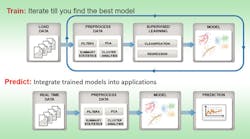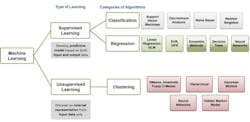This file type includes high-resolution graphics and schematics when applicable.
Analytics-driven embedded systems bring analytics to embedded applications, moving many of the functions found in cloud-based, big-data analytics to the source of data. This allows for more efficient data processing, leading to better real-time response and reduced communication overhead.
I talked with Paul Pilotte, Technical Marketing Manager at MathWorks, about how the company is addressing this area, and how its tools can be used to create analytics-driven embedded systems.
Wong: What are analytics-driven embedded systems and why are they important to today’s design engineers?
Pilotte: The ability to create analytics that process massive amounts of business and engineering data is enabling designers in many industries to develop intelligent products and services. Designers can use analytics to describe and predict a system’s behavior, and further combine analytics with embedded control systems to automate actions and decisions.
Wong: What are applications of analytics-driven embedded systems? Can you provide examples?
Pilotte: In some implementations, the analytics are performed in the cloud to improve embedded-system performance. For example, a team at BuildingIQ designed a building climate-control system that uses analytics to reduce energy consumption. Using engineering data from thermometers, pressure sensors, and other HVAC sensors, as well as business data from weather forecasts and real-time energy prices, the analytics running in BuildingIQ’s cloud service tune the building’s HVAC embedded systems. The result is an analytics-driven system that reduces energy consumption up to 25% in commercial buildings.
In other cases, the analytics run directly in the embedded systems. The design team at Scania, the Swedish truck manufacturer, embeds analytics into their emergency braking systems to provide real-time crash avoidance to reduce accidents and meet stringent EU regulations. Engineering data from cameras and radar are processed in real time for object detection and road-marking detection, and subsequently fused to signal collision warning alerts and automatic brake request. System safety and reliability are ensured with exhaustive test and verification, including test-scenario creation, system modeling with simulated and recorded data, and HIL testing.
Wong: How do designers develop analytics-driven systems?
Pilotte: The first step in developing analytics is to access the wealth of available data to explore patterns and develop deeper insights. The datasets are not only large in size, but also can come from many different sources and represent many different attributes. Therefore, the software tools you use for exploratory analysis and analytics development should be able to access all of the data sources and formats you plan to use.
From there, designers use four main steps when developing analytics-driven systems:
1. Pre-processing massive amounts of data.
2. Developing analytic algorithms.
3. Running analytics and controls in real time.
4. Integrating analytics with sensors and embedded devices, and possibly other non-embedded resources such as IT systems and the cloud.
Wong: Let’s run through the steps together. What is the purpose of pre-processing data? What are some examples of this activity?
Pilotte: Data cleaning and preparation before developing predictive models is incredibly important. For example, data might have missing values or erroneous values, or it might use different timestamp formats. Predictions from erroneous data can be difficult to debug or, even worse, lead to inaccurate or misleading predictions that impact system performance and reliability.
Common pre-processing tasks include cleaning data that has errors, outliers, or duplicates; and handling missing data with discarding, filtering, or imputation. Another important part of pre-processing is data transformation and reduction. The goal here is to find the most predictive features of the data, and filter data that will not enhance the predictive power of the analytics model.
Wong: What are key considerations for developing analytic algorithms? What are common methods?
Pilotte: For starters, it’s important to consider whether an analytic algorithm is your best approach. In cases where system behavior can be well characterized by known scientific equations, proven mathematical modeling can be a simple and efficient way to meet design objectives. For an increasing number of design challenges, though, such as dynamically setting climate-control points in the BuildingIQ example or object identification in the Scania braking application, machine learning is the best approach.
Machine-learning algorithms use computational methods to “learn” information directly from data without relying on a predetermined equation as a model (Fig. 1). The increased availability of “big data,” compute power, and software tools make it easier than ever to use machine learning in engineering applications. Machine learning is broadly divided into two types of learning methods, supervised and unsupervised learning, each containing several algorithms tailored for different problems.
For classification problems involving images, text, and signals, deep learning has emerged as a new category of advanced analytics. When trained on large labeled training datasets (often requiring hardware acceleration with GPUs and intensive training and assessment), deep-learning models can achieve state-of-the-art accuracy, sometimes exceeding human-level performance in object classification.
Wong: So how do engineers implement the analytics?
Pilotte: Figure 2 shows the workflows in which data are accessed and pre-processed, and algorithms are selected. In the training workflow, stored data is used to develop pre-processing code and machine learning to develop a trained model. In the prediction workflow, the same pre-processing code and the trained model are applied to live data to perform real-time analytics.
This workflow can be used to combine engineering, scientific, and field data with business and transactional data. This allows the creation of sophisticated analytics to develop smarter systems. Combining sensor-generated data with other real-time sources and historical data is the power behind IoT, the machine-to-machine coordination of Industry 4.0, and the automotive trend toward a connected and autonomous vehicle.
Wong: How are these embedded analytics used by engineers and companies today, and what are the benefits?
Pilotte: In some system implementations, such as the one developed by BuildingIQ, analytics are performed in enterprise IT systems to improve embedded-system performance. The analytics can be automatically generated as deployable components compatible with IT development environments such as Java, Microsoft .NET, Excel, and C/C++. This enables them to be integrated—without recoding—into web, database, desktop, and scalable enterprise applications running on-premise or in a private or public cloud.
The accelerating IoT trend toward smarter and more connected sensors is adding pressure to move more processing and analytics as close to the sensors as possible. This has the benefit of shrinking the amount of data that’s transferred over the network, which reduces the cost of transmission and can reduce the power consumption of wireless devices.
For embedded-system designers, it’s important to consider not only algorithm performance, but also the overall system robustness, reliability, and cost in the architecture and design. To do this, a Model-Based Design approach can be used to simulate the system, automatically generate embedded code, and continuously test and verify the analytics being integrated into the embedded system.
Wong: What do you expect the future will bring for analytics in embedded systems?
Pilotte: We can expect to see lots of growth and innovation in this area. Data-driven methods like machine learning and deep learning open up exciting opportunities for embedded designs. You see this today with innovation for object recognition for automotive driver assistance, which is a step on the way toward embedded systems for autonomous vehicles.
We’re really just at the beginning. The key is having an efficient and robust workflow to empower the embedded systems engineer to be the data scientist. That includes combining an analytics workflow with an embedded design workflow that includes the system simulation, verification, and hardware targeting that we know are essential.
Looking for parts? Go to SourceESB.




